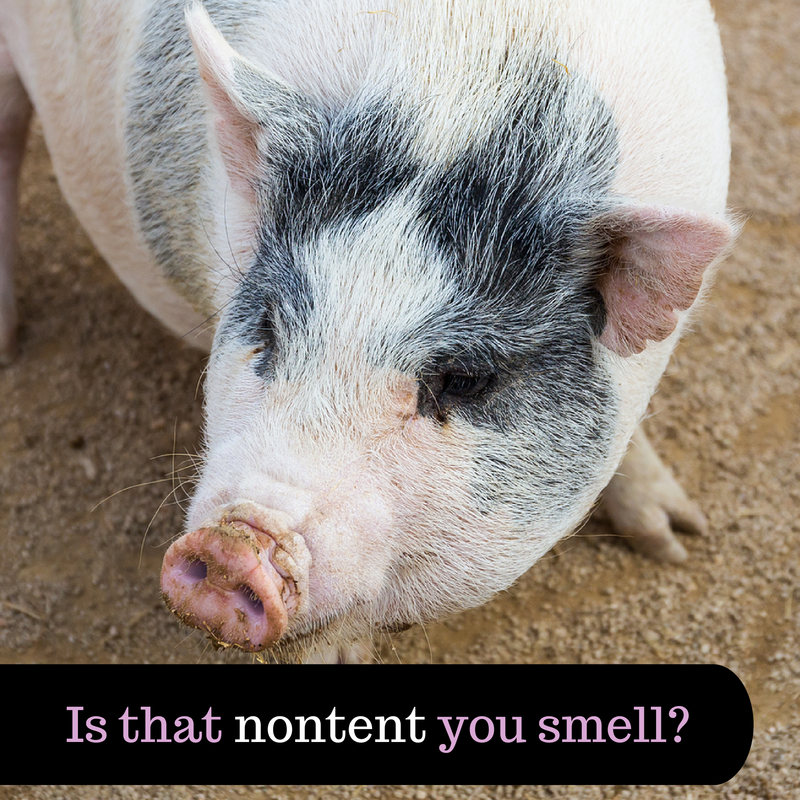Lessons from (and confessions of) a former content farmer.
This is a guest post from Erik Devaney of HubSpot, aka @BardOfBoston, pictured above 😉
Ever stumble across a poorly written, vaguely comprehensible article with a title like, “How to Cook Atlantic Pygmy Octopus on a Weber Grill” or “The Best Types of Blue Flowers for Japanese Rock Gardens”?
Chances are, an article like that came from a content farm: a website that publishes thousands upon thousands of crappy articles, all for the sake of ranking for as many keywords (and keyword combinations) as possible.
If you want to think about them in terms of actual farms, content farms are like giant, multinational agriculture corporations. Corporations like these can have thousands of employees, hundreds of different products, and they often use genetic engineering in order to optimize those products. Likewise, content farms can have thousands of writers, hundreds of different verticals, and they often use black-hat SEO tactics (especially keyword-stuffing) in order to optimize their content for search engines.
Of course, genetic engineering is a tad different from SEO. Yet both are frequently viewed as ways to “game the system,” and often carry with them negative (and unnatural) connotations.
It should come as no surprise then to learn that Google is not a big fan of content farms. And just a few years ago, they made these feelings known to the world with the release of their Panda update.
Panda: Cuddly Name, Deadly Result
Officially, Google’s 2011 Panda update was targeted at websites with “thin” content. What exactly is thin content? There are a number of factors that can lead to Google identifying your content as thin, including 1) having duplicate content on your site, 2) having duplicate content across sites (i.e. the exact same content appears on your site and on another site), and 3) having high ad-to-content ratios on your site’s pages (i.e. your site’s pages are loaded with ads, instead of being loaded with useful content.)
As you may have already deduced, Google’s attack on thin content completely devastated the content farms. In fact, before Google revealed the “Panda” moniker, outside observers were referring to the update as the “Farmer” update, due to its targeting of content farms.
So, how bad was the damage?
For starters, Panda affected 12% of all Google searches. And hundreds of content farms — including ezeinearticles.com, suite101.com, and wisegeek.com — saw their search rankings tank.
One company in particular, which controlled several content farm properties at the time, is speculated to have lost $6.4 million in Q4 of 2011 — a direct result of Panda’s wrath.
Unsurprisingly, this turn of events left many SEOs and online marketers crying foul (or, perhaps more accurately, crying “WTF, Google?”)
Why Panda Was a Good Thing
Ultimately, Google was only trying to make its search engine better with the Panda update. It wasn’t some malicious plot designed to bankrupt businesses. It was simply Google doing us — the search engine-using public — a favor by reorganizing their search results, pushing the crappy stuff to the bottom, and letting the good stuff bubble up to the top.
And based on who took the biggest beatings from Panda, Google clearly doesn’t think that content farms create good stuff. When you do a Google search, the search engine doesn’t want to return genetically engineered mega-results, it wants to return organic results.
From a marketing perspective, I think Panda taught us all a valuable lesson. That lesson: Don’t try to game the system. Don’t try to dose your content with SEO steroids. You will be caught. And you will be punished.
Google would reinforce that lesson in 2012 with the release of Penguin, an update that targeted websites using link schemes, keyword-stuffing, and other black-hat SEO tactics.
The underlying message here is that you shouldn’t be trying to impress the search engines, you should be trying to impress the people using the search engines. And clearly, content farms were doing the former, not the latter.
I would know … I used to write for content farms.
(Cue the dramatic music.)
Coming Clean: I Got Paid to Write a Bunch of Crap
I never really intended to enter, nor contribute to, the shady world of content farms. It just sort of happened. I had just graduated college and was picking up some freelance writing gigs here and there. Before I knew it, I was churning out six to seven 500-word articles per day for an online media company.
Of course, all the crap I was writing was getting published to content farms. (If you search diligently, you can still find some of the crappy posts I wrote floating around on the interwebs.)
And in case you were wondering, here’s how getting hired by a content farm works:
Farm: Do you have a college degree?
Me: Sure.
Farm: Do you have a writing sample?
Yes, here it is.
Farm: Great! You are now free to write about any of the following topics: tech, food, home & garden, health & fitness, entertainment, finance, fashion, astrophysics, paleontology, Euclidean geometry, maritime law …
So what happens when a company hires thousands of (mostly) inexperienced writers to pretend to be experts in a variety of topics? Answer: the overwhelming majority of the content that gets published is total garbage. It is, as Barry might call it, nontent.
And that, my friends, is how a content farm works.
How NOT to Be a Content Farm
1) Know Thy Writers
I sit within shouting distance of my company’s blogging team. They’re awesome, and they’re also very careful about who they let write for the blog. When bringing in outside contributors, they try to find folks who have expertise in particular topics and (as you might expect) encourage them to write about those topics. It’s not astrophysics.
And yet, there’s still plenty of room for screwing it up. If your blog is starting to resemble a forum discussion – hundreds of contributors, all of them with publishing power, no regular posting times … that might send a message to Google that something fishy is going on. Are you a content farm? Are you running a link exchange scheme?
Bottom-line here: Don’t just let any Joe Schmoe write for your blog. Find smart folks who can write within your niche. Which brings us to …
2) Know Thy Niche
HubSpot is an inbound marketing software company, so we write primarily about inbound marketing. But as our company expands its product offerings into different areas — namely, sales — we’ve also allowed the topics we cover to expand in order to follow suit.
With content farms, there really isn’t any alignment around a niche or area of expertise: the goal is to write as much crap about as much stuff as possible. If people are searching for it, content farms want to write about it.
You, of course, should be more selective with your topics. Specifically, you want to be writing for your target audience(s).
3) Know Thy Target Audience
Back during my content farming days, I never wrote for anyone in particular. I just wrote.
 At HubSpot, we use buyer personas – representations of our ideal customers – to help guide our topic selection. Our goal isn’t to create content that everyone in the world wants to read, we want to create content that the right people want to read. These are people who want to learn more about the topics we cover, people who will join our online discussions, and, of course, people who could potentially become customers.
At HubSpot, we use buyer personas – representations of our ideal customers – to help guide our topic selection. Our goal isn’t to create content that everyone in the world wants to read, we want to create content that the right people want to read. These are people who want to learn more about the topics we cover, people who will join our online discussions, and, of course, people who could potentially become customers.
In contrast, content farms tend to target everyone indiscriminately. If you’re using the internet, and can click on a link, you’re exactly who the content farms are looking for.
Alright, that’s enough ragging on content farms for one day. Truth be told, I’m grateful for the opportunities I had writing awful content for them. I ended up learning a lot about content creation and SEO and inbound marketing in the process.
Oh yea, and I also leaned how cook an Atlantic Pygmy Octopus on a Weber grill.
 Pssst. Want to learn more about the relationship between high-quality content and SEO? Check out this new guide I put together, Learning SEO From the Experts.
Pssst. Want to learn more about the relationship between high-quality content and SEO? Check out this new guide I put together, Learning SEO From the Experts.
 Erik Devaney, content strategist, HubSpot
Erik Devaney, content strategist, HubSpot
@BardOfBoston
As a content strategist at HubSpot, Erik spends his days planning, writing, & designing resources for the modern marketer. Prior to joining the HubSpot crew, he was a marketing manager at the real estate tech company Placester, and a content creator for the native advertising platform Dailybreak.








Comments
11 Mistakes Dumbass Content Marketers Make | Feldman Creative
[…] How Publishing Crappy Content Ruins Your Rankings […]
11 Mistakes Dumbass Content Marketers Make | Drip Logic
[…] marketing experts preach the need for volume, and companies often respond by forgoing quality. Publishing crappy content will not produce the desired results. In fact, it will […]
Where Keywords Fit Into the Future of SEO | HelloMarketingAutomation.com
[…] Panda cracked down on “thin” (aka crappy) content and content farms, Penguin went after link schemes, keyword-stuffing, and other black hat […]
Where Keywords Fit Into the Future of SEO | SEO BACKLINK
[…] Panda cracked down on “thin” (aka crappy) content and content farms, Penguin went after link schemes, keyword-stuffing, and other black hat […]
Where Keywords Fit Into the Future of SEO | Blog E-Course
[…] Panda cracked down on “thin” (aka crappy) content and content farms, Penguin went after link schemes, keyword-stuffing, and other black hat […]
Where Keywords Fit Into the Future of SEO | IM Aggregator
[…] Panda cracked down on “thin” (aka crappy) content and content farms, Penguin went after link schemes, keyword-stuffing, and other black hat […]
Where Keywords Fit Into the Future of SEO
[…] Panda cracked down on "thin" (aka crappy) content and content farms, Penguin went after link schemes, keyword-stuffing, and other black hat […]
Where Keywords Fit Into the Future of SEO | Online Digital Profits
[…] Panda cracked down on “thin” (aka crappy) content and content farms, Penguin went after link schemes, keyword-stuffing, and other black hat […]
Where Keywords Fit Into the Future of SEO | WORTH SEO PANDA
[…] Panda cracked down on “thin” (aka crappy) content and content farms, Penguin went after link schemes, keyword-stuffing, and other black hat […]